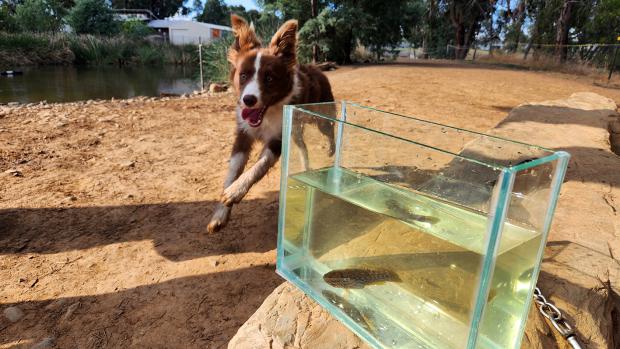Loading
Resilient fish making Bendigo comeback

Three native fish species previously thought to be extinct are showing signs of a strong revival in a Bendigo park better known for furry, rather than finned inhabitants.
Numbers of the southern purple spotted gudgeon (aka zombie fish), olive perchlet, and southern pygmy perch are booming in their new home – a Bendigo off-leash dog park.
The southern pygmy perch has been extinct from the Bendigo Creek since the 1860s gold rush. Olive perchlet were last recorded in Victoria in 1929, and the southern purple spotted gudgeon was thought to be extinct in Victoria until 2019, when it was re-discovered in the Reedy Lakes system near Kerang.
North Central Catchment Management Authority (CMA) has been working on a recovery plan with SEA LIFE Melbourne Aquarium, City of Greater Bendigo, Victorian Fisheries Authority, and the Tri State Alliance – a group of seven natural resource bodies along the Murray from Victoria, New South Wales, and South Australia.
A key in that plan was finding a series of fish-friendly wetlands across the region, and Bendigo’s Harcourt Dog Park is proving to be the star attraction.
“We have been stocking these fish into the dog park wetlands for the past three years, and the response has been fantastic,” North Central CMA Project Manager Peter Rose said.
“Our last survey recorded 123 olive perchlet, 124 southern pygmy perch, and 60 zombie fish, all different ages,” he said.
“Not only does that mean they’re breeding, but they’re breeding alongside each other, which is great news.
“Pygmy perch and zombie fish have also moved into Racecourse Creek out of the dog park wetlands, and are now breeding there, which is phenomenal.”
SEA LIFE Melbourne Aquarium Exhibit Manager Tereza Todd said she organisation was proud partners in the project.
“We have had great success in breeding olive perchlet at SEA LIFE Melbourne,” she said.
“We are so proud to be part of this conservation project that is helping improve habitats while also educating the public who can see them up close at the aquarium.”
The breeding program forms part of the North Central CMA’s Native Fish Recovery Plan to restore native fish populations and waterway health across the central Murray and lower Loddon systems.
“The next step for these fish is to keep breeding them and helping them thrive in surrogate sites such as the dog park wetlands,” Dr Rose said.
“From there, we’ll introduce them back into the wild in wetlands in the Gunbower Forest and on the Loddon floodplain.
The work has been supported through Department of Energy, Environment and Climate Action’s Nature Fund.
